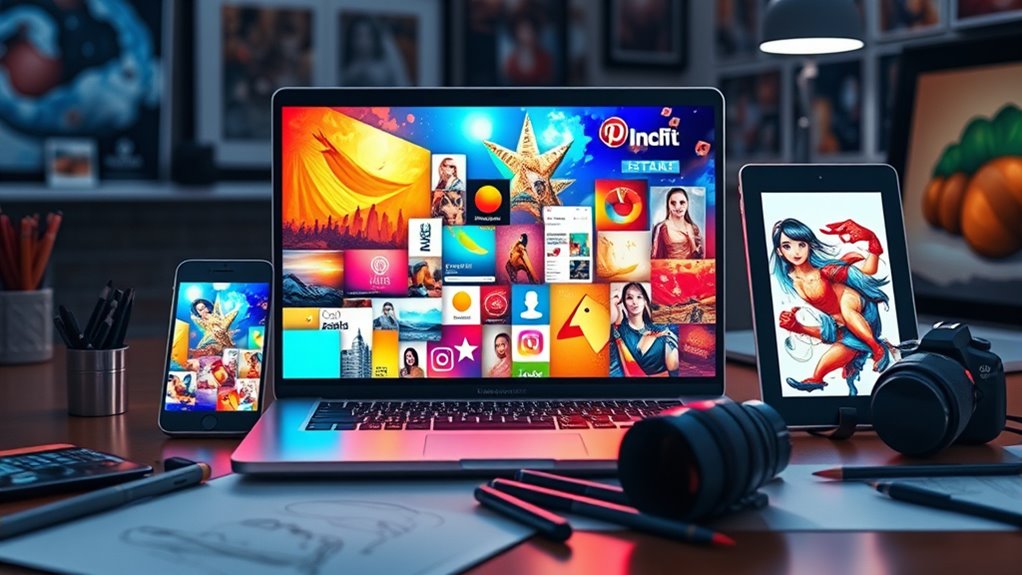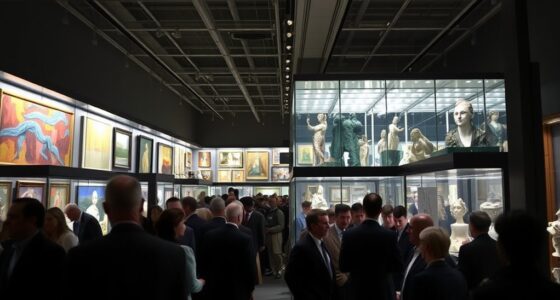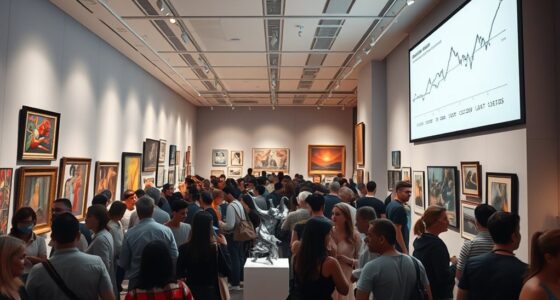Digital platforms are transforming the art market by expanding access and increasing online sales channels. You can discover and buy art more easily through virtual galleries, social media, and auction sites. Artists benefit from direct exposure and lower costs, while collectors enjoy transparency and global reach. However, there are challenges like authenticity concerns and shipping risks. As technology advances, these digital trends keep shaping how you buy and sell art—exploring further reveals exciting future developments.
Key Takeaways
- Digital platforms significantly expand access to global art markets, facilitating easier buying and selling online.
- Online sales channels experience rapid growth, transforming traditional art commerce into more accessible digital transactions.
- Social media and virtual marketplaces enable direct artist-to-collector interactions, fostering personalized connections.
- Innovations like blockchain and virtual reality enhance security, provenance, and immersive art experiences online.
- The shift towards digital platforms democratizes art purchasing, increasing transparency, competition, and market inclusivity.
The Rise of Online Marketplaces and Auction Sites

Online marketplaces and auction sites have transformed the way art is bought and sold, making it more accessible than ever before. You can now browse a vast array of artworks from around the world without leaving your home. These platforms eliminate traditional barriers, allowing you to discover pieces from emerging artists and established masters alike. The auction model creates excitement and competition, often driving up prices and providing opportunities for buyers to acquire unique works. With user-friendly interfaces and detailed listings, you can easily compare prices, view high-resolution images, and learn about artists’ backgrounds. This digital shift democratizes art purchasing, giving you more control, transparency, and convenience in building a collection or finding the perfect piece. Integrating email marketing tools can further enhance your experience by providing personalized recommendations and updates on upcoming sales.
Social Media’s Role in Art Discovery and Sales

Social media platforms have become powerful tools for discovering and purchasing art, connecting artists directly with audiences worldwide. You can browse visual content, follow your favorite artists, and explore new styles instantly. Platforms like Instagram and TikTok enable artists to showcase their work in real time, reaching broad audiences without traditional gatekeepers. This immediacy fosters quicker recognition and sales, often through direct messages or embedded links to online shops. Social media also allows collectors to discover emerging artists early, building personal connections along the way. Hashtags, algorithms, and curated feeds help tailor your art discovery experience, making it easier to find pieces that resonate with your taste. Additionally, understanding the rendering lard process has inspired many artists to incorporate traditional techniques into their digital art practices, blending old-world craftsmanship with modern technology. Overall, social media accelerates the art market’s pace, making it more accessible and dynamic for everyone involved.
Benefits for Artists and Collectors in the Digital Age

The rise of digital platforms has transformed how artists and collectors benefit from the art market. You gain broader exposure, making it easier to reach a global audience without traditional gallery costs. As an artist, you can showcase your work directly, reducing reliance on middlemen and increasing your earnings. Collectors enjoy access to a vast selection of artworks, often at lower prices and with transparent pricing. Digital platforms also offer tools for authenticating and tracking provenance, adding trust. Plus, you can participate in online auctions or exclusive drops, creating unique opportunities. Incorporating decentralized verification methods can further enhance trust and security in digital art transactions.
Challenges and Risks of Buying Art Online

While buying art online offers convenience and access to a wide range of works, it also comes with significant risks. One major concern is authenticity; without physically inspecting the piece, you might encounter counterfeit or misrepresented artworks. Shipping damage or loss is another risk, especially for fragile or valuable pieces. Additionally, some online platforms may lack transparency about the artist’s credentials or provenance, making it harder to verify a piece’s true origin. Payment fraud is also a threat, so you should be cautious with payment methods and only use trusted platforms. Finally, you might face difficulty evaluating the artwork’s true appearance, texture, or size from digital images alone, which can lead to disappointment or misinformed purchasing decisions. Understanding color accuracy is essential, as it directly impacts how accurately the digital image reflects the actual artwork’s hues and details.
The Future Trends in Digital Art Commerce

You’ll likely see virtual reality become a standard way to experience art collections online, making viewing more immersive than ever. Blockchain technology will also simplify verifying ownership and authenticity of digital artworks, giving you more confidence in your purchases. These innovations are shaping the future of digital art commerce, making it more secure and engaging for collectors like you. Additionally, evidence-based insights into emerging technologies will help guide your decisions in this evolving market.
Virtual Reality Showcases
Harnessing virtual reality (VR) technology is transforming how digital art is experienced and purchased. With VR, you can immerse yourself in a virtual gallery, walk around exhibits, and view artworks from different angles—all from your home. This technology bridges the gap between online and in-person viewing, making art more accessible and engaging. You can interact with pieces in a way that feels real, gaining a better sense of scale and detail. VR showcases also allow artists and galleries to create unique, immersive experiences that attract more collectors. Imagine exploring a virtual exhibition with friends or clients, sharing impressions instantly. As this tech evolves, expect to see more personalized, interactive, and memorable art-buying experiences that deepen your connection to the pieces. Incorporating authentic materials and thoughtful decor can further enhance the viewing experience, making virtual galleries feel more inviting and genuine.
Blockchain Ownership Verification
As virtual reality expands how we experience and showcase digital art, verifying ownership becomes increasingly important in this evolving landscape. Blockchain technology provides a secure, transparent way to authenticate and track digital art ownership. It creates an immutable record, ensuring that each piece’s provenance is clear and tamper-proof. This reduces fraud and gives collectors confidence in their purchases. Here’s a quick comparison:
| Feature | Traditional Verification | Blockchain Verification | Benefits |
|---|---|---|---|
| Authenticity Proof | Certificates, receipts | Digital, tamper-proof record | Increased trust and security |
| Transfer Process | Manual, paper-based | Automated via smart contracts | Faster, less costly transactions |
| Ownership History | Disputed or incomplete | Transparent, accessible | Clear provenance for future buyers |
Blockchain is transforming digital art commerce by making ownership more reliable and traceable. Secure provenance is now achievable through these innovative digital solutions.
Impact on Traditional Art Galleries and Brick-and-Mortar Stores

The rise of online art sales has considerably challenged traditional galleries and brick-and-mortar stores by shifting consumer attention toward digital platforms. You might find fewer visitors browsing in physical spaces, which impacts sales and foot traffic. Many galleries now compete with online marketplaces offering broader selections and lower prices. You could also notice a decline in the need for large, expensive showrooms. To stay relevant, some galleries are embracing digital strategies, hosting virtual exhibitions, and building online presence. Meanwhile, physical stores face the challenge of maintaining exclusivity and personal connections in a digital world. Essentially, the market’s landscape is shifting, pushing traditional venues to adapt or risk obsolescence. Staying innovative is key to bridging the gap between physical and virtual art experiences.
Frequently Asked Questions
How Do Online Platforms Verify the Authenticity of Artworks?
Online platforms verify artwork authenticity through a mix of expert authentication, detailed provenance documentation, and technology like blockchain. They often require artists or sellers to submit certificates or proof of origin. Some platforms collaborate with art experts and appraisers to confirm legitimacy. Blockchain provides an immutable record, ensuring transparency and preventing forgery. By combining these methods, you can trust that the artworks listed are genuine and accurately represented.
What Legal Protections Exist for Online Art Transactions?
They say a chain is only as strong as its weakest link, so legal protections matter. You’re protected by consumer laws, which include fraud prevention, dispute resolution, and clear refund policies. Many platforms also offer escrow services and digital signatures to safeguard your transactions. Always read the terms of service and verify seller credentials. These measures help keep your online art purchases safe and secure, giving you peace of mind.
How Do Digital Platforms Influence Art Pricing and Valuation?
Digital platforms influence art pricing and valuation by providing transparent data on sales, artist popularity, and market trends. You can see real-time prices, which helps you assess an artwork’s worth more accurately. These platforms also foster buyer and seller feedback, shaping perceptions of value. As a result, you’re better equipped to make informed decisions, and prices often become more consistent due to increased market visibility and competition.
What Are the Environmental Impacts of Online Art Shipping?
Shipping art online can impact the environment through increased carbon emissions from transportation, especially if artworks travel long distances. You might also contribute to waste if packaging materials aren’t eco-friendly or reused. However, digital platforms can promote sustainability by encouraging local sales, reducing the need for extensive shipping, and supporting eco-conscious packaging options. Being mindful of these factors helps you minimize your environmental footprint while selling or buying art online.
How Accessible Are Online Art Markets for Emerging Artists?
Accessible art markets offer emerging artists ample opportunities to showcase their skills and reach wider audiences. Digital platforms diminish barriers, making it easier for you to upload, promote, and sell your artwork without the need for traditional galleries. You can connect with collectors globally, build your brand, and grow your career conveniently from your studio. While competition is fierce, persistence and strategic online presence can propel your artistic pursuits forward.
Conclusion
As you navigate this digital art revolution, remember that like Da Vinci’s brushstroke transforming canvases, online platforms are reshaping how art is discovered and sold. Embrace the opportunities, but stay mindful of the challenges lurking in the digital shadows. The future promises a landscape where creativity and technology collide, much like the myth of Icarus aiming for the sun—bold, innovative, and ever-evolving. Your journey into online art awaits.









